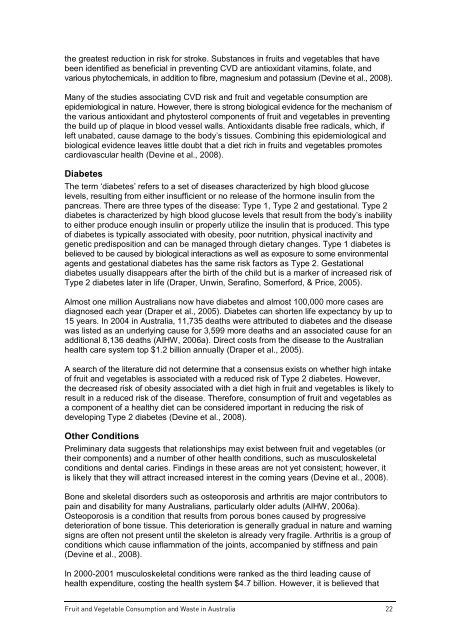Fruit and vegetable consumption and waste in Australia - VicHealth
Fruit and vegetable consumption and waste in Australia - VicHealth
Fruit and vegetable consumption and waste in Australia - VicHealth
You also want an ePaper? Increase the reach of your titles
YUMPU automatically turns print PDFs into web optimized ePapers that Google loves.
the greatest reduction <strong>in</strong> risk for stroke. Substances <strong>in</strong> fruits <strong>and</strong> <strong>vegetable</strong>s that have<br />
been identified as beneficial <strong>in</strong> prevent<strong>in</strong>g CVD are antioxidant vitam<strong>in</strong>s, folate, <strong>and</strong><br />
various phytochemicals, <strong>in</strong> addition to fibre, magnesium <strong>and</strong> potassium (Dev<strong>in</strong>e et al., 2008).<br />
Many of the studies associat<strong>in</strong>g CVD risk <strong>and</strong> fruit <strong>and</strong> <strong>vegetable</strong> <strong>consumption</strong> are<br />
epidemiological <strong>in</strong> nature. However, there is strong biological evidence for the mechanism of<br />
the various antioxidant <strong>and</strong> phytosterol components of fruit <strong>and</strong> <strong>vegetable</strong>s <strong>in</strong> prevent<strong>in</strong>g<br />
the build up of plaque <strong>in</strong> blood vessel walls. Antioxidants disable free radicals, which, if<br />
left unabated, cause damage to the body’s tissues. Comb<strong>in</strong><strong>in</strong>g this epidemiological <strong>and</strong><br />
biological evidence leaves little doubt that a diet rich <strong>in</strong> fruits <strong>and</strong> <strong>vegetable</strong>s promotes<br />
cardiovascular health (Dev<strong>in</strong>e et al., 2008).<br />
Diabetes<br />
The term ‘diabetes’ refers to a set of diseases characterized by high blood glucose<br />
levels, result<strong>in</strong>g from either <strong>in</strong>sufficient or no release of the hormone <strong>in</strong>sul<strong>in</strong> from the<br />
pancreas. There are three types of the disease: Type 1, Type 2 <strong>and</strong> gestational. Type 2<br />
diabetes is characterized by high blood glucose levels that result from the body’s <strong>in</strong>ability<br />
to either produce enough <strong>in</strong>sul<strong>in</strong> or properly utilize the <strong>in</strong>sul<strong>in</strong> that is produced. This type<br />
of diabetes is typically associated with obesity, poor nutrition, physical <strong>in</strong>activity <strong>and</strong><br />
genetic predisposition <strong>and</strong> can be managed through dietary changes. Type 1 diabetes is<br />
believed to be caused by biological <strong>in</strong>teractions as well as exposure to some environmental<br />
agents <strong>and</strong> gestational diabetes has the same risk factors as Type 2. Gestational<br />
diabetes usually disappears after the birth of the child but is a marker of <strong>in</strong>creased risk of<br />
Type 2 diabetes later <strong>in</strong> life (Draper, Unw<strong>in</strong>, Seraf<strong>in</strong>o, Somerford, & Price, 2005).<br />
Almost one million <strong>Australia</strong>ns now have diabetes <strong>and</strong> almost 100,000 more cases are<br />
diagnosed each year (Draper et al., 2005). Diabetes can shorten life expectancy by up to<br />
15 years. In 2004 <strong>in</strong> <strong>Australia</strong>, 11,735 deaths were attributed to diabetes <strong>and</strong> the disease<br />
was listed as an underly<strong>in</strong>g cause for 3,599 more deaths <strong>and</strong> an associated cause for an<br />
additional 8,136 deaths (AIHW, 2006a). Direct costs from the disease to the <strong>Australia</strong>n<br />
health care system top $1.2 billion annually (Draper et al., 2005).<br />
A search of the literature did not determ<strong>in</strong>e that a consensus exists on whether high <strong>in</strong>take<br />
of fruit <strong>and</strong> <strong>vegetable</strong>s is associated with a reduced risk of Type 2 diabetes. However,<br />
the decreased risk of obesity associated with a diet high <strong>in</strong> fruit <strong>and</strong> <strong>vegetable</strong>s is likely to<br />
result <strong>in</strong> a reduced risk of the disease. Therefore, <strong>consumption</strong> of fruit <strong>and</strong> <strong>vegetable</strong>s as<br />
a component of a healthy diet can be considered important <strong>in</strong> reduc<strong>in</strong>g the risk of<br />
develop<strong>in</strong>g Type 2 diabetes (Dev<strong>in</strong>e et al., 2008).<br />
Other Conditions<br />
Prelim<strong>in</strong>ary data suggests that relationships may exist between fruit <strong>and</strong> <strong>vegetable</strong>s (or<br />
their components) <strong>and</strong> a number of other health conditions, such as musculoskeletal<br />
conditions <strong>and</strong> dental caries. F<strong>in</strong>d<strong>in</strong>gs <strong>in</strong> these areas are not yet consistent; however, it<br />
is likely that they will attract <strong>in</strong>creased <strong>in</strong>terest <strong>in</strong> the com<strong>in</strong>g years (Dev<strong>in</strong>e et al., 2008).<br />
Bone <strong>and</strong> skeletal disorders such as osteoporosis <strong>and</strong> arthritis are major contributors to<br />
pa<strong>in</strong> <strong>and</strong> disability for many <strong>Australia</strong>ns, particularly older adults (AIHW, 2006a).<br />
Osteoporosis is a condition that results from porous bones caused by progressive<br />
deterioration of bone tissue. This deterioration is generally gradual <strong>in</strong> nature <strong>and</strong> warn<strong>in</strong>g<br />
signs are often not present until the skeleton is already very fragile. Arthritis is a group of<br />
conditions which cause <strong>in</strong>flammation of the jo<strong>in</strong>ts, accompanied by stiffness <strong>and</strong> pa<strong>in</strong><br />
(Dev<strong>in</strong>e et al., 2008).<br />
In 2000-2001 musculoskeletal conditions were ranked as the third lead<strong>in</strong>g cause of<br />
health expenditure, cost<strong>in</strong>g the health system $4.7 billion. However, it is believed that<br />
<strong>Fruit</strong> <strong>and</strong> Vegetable Consumption <strong>and</strong> Waste <strong>in</strong> <strong>Australia</strong> 22


